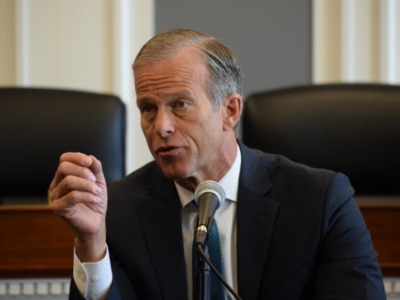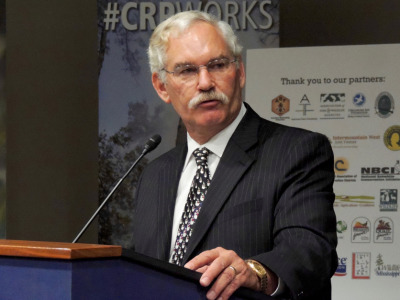Lawmakers appear far from reaching agreement on a new farm bill, but farmers and consumers needn’t fear the possibility of $10-a-gallon milk next year. That prospect will almost certainly ensure that Congress passes some kind of extension of the 2018 farm bill by early 2024.
The looming expiration of the 2018 farm bill will bring back the threat of the “dairy cliff,” the triggering of laws dating back to 1938 and 1949 that would force USDA to take steps to dramatically raise the price of milk, wheat and other commodities. Collectively, the 1938 and 1949 provisions are known as “permanent law” and have been left on the books precisely to ensure Congress either passes a new farm bill or extends the expiring legislation.
USDA would be required under permanent law to start buying up enough milk, butter and other products to maintain dairy prices at 75% to 90% of the “parity price,” a level in line with where milk prices happened to be in 1910-1914.
For dairy, the parity price is $67.70 per hundredweight; 75% of that would be $50.70, according to a new report by the Congressional Research Service. By comparison, the average farm price was $19.30 in January.
Economists at the University of Minnesota tell Agri-Pulse USDA might have to purchase as much as 15% to 25% of U.S. dairy products to push the farm price of milk to $50.70. That, in turn, would cause the retail price of milk to more than double. The average retail price of whole milk in July was $4.34 a gallon, and prices in some cities were as high as $5 and $6 a gallon, according to USDA.
CRS estimates that USDA purchases would cost the federal government as much as $15 billion to $19 billion a year.
While none of that is going to happen, it does raise the question of how long Congress has before it must pass an extension of the 2018 farm bill. Senate GOP Whip John Thune, R-S.D., said last week that leaders of the Senate Ag Committee didn’t appear to be “anywhere close to moving a bill yet.”
 Sen. John Thune, R-S.D.
Sen. John Thune, R-S.D.Technically, permanent law for dairy would trigger as soon as Jan. 1, but USDA officials couldn’t act immediately to implement permanent law, even if they wanted to, because the department would have to first write regulations to carry it out.
USDA would have still more time to address commodities such as wheat and corn, which would have parity prices of $20.40 and $15.30 per bushel respectively, because the existing programs for those and other row crops continue in effect for the commodities' marketing year, according to CRS. The marketing year for wheat runs through May 31. For corn, the marketing year ends Aug. 31.
Implementing permanent law for row crops could potentially be even more complicated and time-consuming than manipulating milk prices, because for some commodities USDA would be required to set marketing quotas and acreage allotments and hold farmer referendums.
Former House Agriculture Committee Chairman Collin Peterson, D-Minn., thinks Congress will have to pass an extension of the 2018 farm bill in December or early 2024. But how long that extension will be depends on whether leaders of the House and Senate Agriculture committees are making any progress in resolving major sticking points, including whether and by how much to raise Price Loss Coverage reference prices, he said.
But if negotiations are making progress in December, and there’s a pathway to final agreement, a short-term extension into early 2024 would be enough, Peterson told Agri-Pulse.
On the other hand, “if they're still sitting in the same position that they are today, where they want more money for this and that — but there's no more money that's been determined — at that point, I'm not sure a short-term extension does a whole lot of good,” Peterson said.
In that case, Peterson believes the 2018 farm bill could be extended all the way to December 2024 to get past the election.
Peterson has plenty of experience dealing with farm bill extensions and the “dairy cliff.” The 2002 bill had to be extended multiple times to give Congress time to finally pass a bill in mid-2008.
The 2008 bill then had to be extended for a full year, through 2013, after Congress failed to meet the 2012 deadline for passing new legislation. The new bill was ultimately enacted in February 2014; permanent law was allowed to trigger in January 2014 after the yearlong extension expired, but USDA took no steps to implement the dairy provisions.
Don't miss a beat! Sign up for a FREE month of Agri-Pulse news! For the latest on what’s happening in agriculture in Washington, D.C. and around the country, click here.
The House, under GOP control at the time, had passed a short-term extension in December 2013, but the Democratic-controlled Senate refused to consider it, keeping the pressure on negotiators to wrap up the new law.
“The hope was at that time that we would get a farm bill sooner rather than later, and we wouldn't have to make the decision” to implement permanent law, said Michael Scuse, who was USDA’s undersecretary in charge of farm programs at the time.
 Delaware Ag Secretary Michael Scuse“Fortunately, that was the case, we were only delayed, so that took permanent law off the table. I would envision something probably similar happening this year,” said Scuse, who is now Delaware’s agriculture secretary.
Delaware Ag Secretary Michael Scuse“Fortunately, that was the case, we were only delayed, so that took permanent law off the table. I would envision something probably similar happening this year,” said Scuse, who is now Delaware’s agriculture secretary.
“I said a year ago that I didn't think that farm bill would be done on time, that I looked for a January-February time frame then, and I still think that that's going to be the case,” he added. “We're probably going to look at a January-February time frame for the next one.”
Ensuring that permanent law isn’t implemented is far from the only problem lawmakers will have to deal with in the coming months while they try to reach an agreement on a new bill. Some smaller programs in the 2018 farm bill will lose their funding authority after Sept. 30, including the Market Access Program and Foreign Market Development, which fund foreign market promotion efforts for U.S. ag commodities.
In addition, provisions in some conservation programs, including the $450,000 payment cap for the Environmental Quality Incentives Program and a 50% set-aside for EQIP-funded livestock projects, also expire after Sept. 30, according to the CRS report.
Another question mark is the Conservation Reserve Program; the Inflation Reduction Act extended authority for other major programs through 2031, but the CRS report notes CRP was not among them.
Jonathan Coppess, a farm policy specialist at the University of Illinois who served as an administrator of the Farm Service Agency during the Obama administration, believes that a provision in the IRA will ensure USDA continues making payments to CRP contract holders and possibly even re-enroll landowners.
Noah Wicks contributed to this report.
For more news, go to Agri-Pulse.com.


